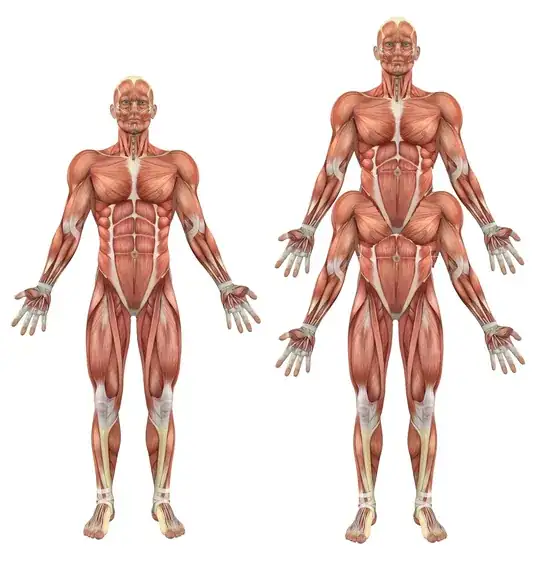Research
Birds have:
- Air foil (i.e., wings that taper at the bottom),
- Muscles and bones to allow rotating wings forward and down including strong breast muscle,
- Large lungs, and
- Hollow bone.
The problem is presence of arms inherently contradicting design; they add weight and prevent a body shape that cuts air. Whether wings are bat- or bird-like is undecided. Bats are logical; humans and bats have skin and it is easier to care for. However, bats are anatomically different from birds and add weight.
My concept was, "Layer wing below arm muscle." Wings become centre-balanced, providing muscle for both (However, I am unsure; lower arm placement may shield arms better in flight). See below:
Imagery does not reflect final product (i.e., it is not humanoid) but muscle placement. The first image has less muscle support and weight, but I'm considering both for design. Birds tuck limbs in during flight. An early concept was for arms to mimic wings, but arm muscle and bone interfere with air. I consider reducing bone size to facilitate this, but arms may then be too weak for use.
Above is an image of how bird legs form an "accordion." This would be useful for arm design and reduce air resistance. Again, this may be made slightly more useful by having arms below wings but would mean that wings are not the centre. There's no way to have wing and arm on the same muscle. Either way, the added load of muscle would require the animal to be broader.
Additional Detail
Existing in Earthen gravity, it would need a large, muscled keel and incredibly efficient respiratory and circulatory systems to function: one-way air flow into lungs for high-speed diving and air sacs to keep lungs inflated even as it exhales. Its heart beats hundreds of times per minute for oxygen to travel at high rates. Tubercles in the nostrils break up wind to allow breath in flight.
This prevents fatigue, allowing wing-flapping four times per second and hence speed if it is anatomically flight-capable. Skin or feathers are slim, stiff, and curved before reaching a straight point to prevent drag. Wide, front-facing eyes with depth perception, a third eyelid, and extra tear gland keep eyes clean and useful.
All features add weight including large wingspan and semi-intelligent brain. Using flight-capable Teratornis, which is roughly the size of man, as a model for how heavy it can be, weight of arms, legs, and lower body would be redistributed to keel, skull, wings, etc., which would then balance out the body without exceeding maximum mass.
Question
It is impossible for an animal to fly if it resembles a human with wings, but (with these anatomy and physiology changes) could the body (being essentially a bird's body with a human-like skull and arms that resemble bird legs) support functional wings and arms?


